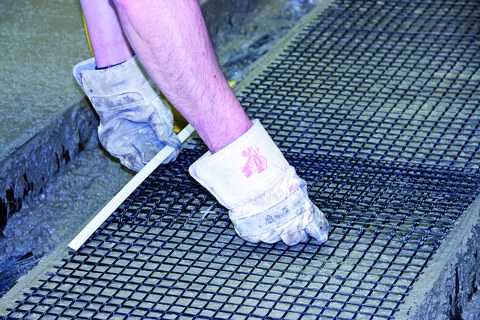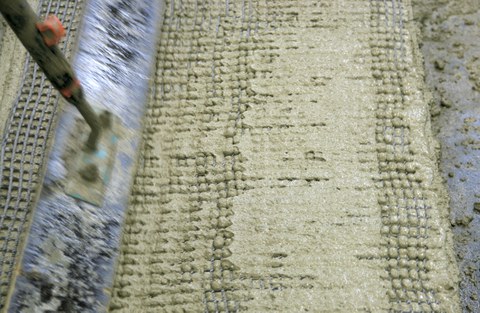Kennwertermittlung von TRC bei Anwendung an wasserundurchlässigen Betonkonstruktionen
Inhaltsverzeichnis
Projektdaten
|
Titel | Title |
Bericht aus dem Jahrbuch 2011
Carbonbewehrung für wasserundurchlässigen Normalbeton

Überlappungsstoß mit GRID 400
Im Rahmen einer Industriekooperation mit der Firma Quinting Zementol GmbH wird die Eignung von Carbontextilien zur Erzielung von wasserundurchlässigen Betonkonstruktionen untersucht. Die Carbonstrukturen werden hierbei als zusätzliche Bewehrung im Bereich
der Betondeckung, also relativ oberflächennah, eingebaut. Ermöglicht wird dies durch ein spezielles Herstellungsverfahren, welches die Firma
entwickelt hat.
Durch die Anordnung des Textils in der sonst unbewehrten Betondeckung ca. 5 mm unter der Oberfläche wird erreicht, dass die beim Reißen des Betons frei werdende Rissenergie mit günstigerem statischem Hebelarm in den Gelegen aufgenommen wird. Damit können die absoluten Rissbreiten wesentlich verkleinert werden. Die Wasserundurchlässigkeit einer solchen Betonkonstruktion wird deutlich verbessert.
Im Rahmen des Projektes wurden hauptsächlich 4-Punkt-Biegeversuche durchgeführt, in denen die Rissbildung mit einem speziell angepassten 2D-Photogrammetriesystem kontinuierlich beobachtet wurde. So konnte der Einfluss der textilen Bewehrung auf die Rissentstehung und -entwicklung im Gebrauchslastzustand beobachtet und quantifiziert werden. Mit dem Textil SGL GRID 600 (ca. 600 g/m²) ist es möglich die Rissbreiten im Gebrauchslastzustand von 0,3 bis 0,4 mm auf 0,1 bis 0,15 mm zu begrenzen. Das Gleiche kann mit einer 400-g/m²-Struktur (SGL GRID 400) erreicht werden, wenn die Garne
zusätzlich besandet werden.
Begleitet werden die Laborexperimente durch bautechnische Einbauversuche auf Großbaustellen und durch Wirtschaftlichkeitsbetrachtungen. Es konnte gezeigt werden, dass die textile Bewehrung mit dem Verfahren der Firma Quinting Zementol GmbH lagesicher und mit ausreichender Betondeckung eingebaut werden kann. Der gute Verbund zur Betonmatrix wird über die Art der Nachbehandlung und Nachverdichtung
erreicht und sichergestellt. Auch Übergreifungsstöße konnten ohne größere Schwierigkeiten ausgeführt werden.
In diesem Projekt konnte somit nachgewiesen werden, dass textile Strukturen in einen Normalbeton mit einem üblichen Größtkorn von 16 bis 32 mm eingesetzt werden können. Ein spezieller Feinbeton ist somit nicht zwingend erforderlich, um die positiven Eigenschaften der textilen Strukturen zu aktivieren. Das Verfahren ist sowohl im Labor als auch unter den rauen Bedingungen einer Großbaustelle sicher anwendbar. Die gewählten Carbon-Textilien sind ausreichend robust für dieses Einsatzgebiet. Das Vorhaben wurde Ende 2011 abgeschlossen, ein Abschlussbericht ist verfügbar.
Bericht aus dem Jahrbuch 2010
Carbonbewehrung für wasserundurchlässigen Normalbeton

Einarbeiten der textilen Carbonbewehrung
Im Rahmen einer durch die AiF geförderten Industriekooperation wird die Eignung von Textilbeton zur Erzielung von wasserundurchlässigen Betonkonstruktionen untersucht. Bei üblichen Betonbauteilen wird eine 4 bis 5 cm starke Betondeckung über dem Bewehrungsstahl angeordnet. Damit existiert aber auch ein ebenso starker unbewehrter Betonbereich. Bei Biegung tritt die maximale Beanspruchung immer am äußeren Rand auf, also in diesem unbewehrten Bereich. Mit Entstehung eines Risses wird die gesamte in diesem Bereich gespeicherte Energie frei und muss von der tief liegenden Betonstahlbewehrung aufgenommen werden. So können verhältnismäßig breite Risse entstehen. Durch das Anordnen einer oberflächennahen Carbon-Bewehrung in dem bisher unbewehrten Betonbereich ist zu erwarten, dass die Rissbreiten wesentlich verkleinert werden können. Damit sollte die Wasserundurchlässigkeit einer solchen Betonkonstruktion deutlich verbessert werden. Ein weiterer Effekt ist, dass der Beton infolge der kleineren Rissbreiten auch dichter gegenüber anderen Einflüssen ist. Damit könnte die Betondeckung über der Betonstahlbewehrung reduziert und dennoch die gleiche Schutzwirkung für die Bewehrung erreicht werden.
Bearbeitung
Neu an dem Verfahren ist, dass textile Strukturen in einen Normalbeton mit üblichem Größtkorn von 32 bis 64 mm eingebaut werden. Bisher wird zur optimalen Interaktion zwischen Faser und Matrix i. d. R. ein spezieller Feinbeton eingesetzt. In diesem Forschungsvorhaben wird untersucht, welche Carbon-Strukturen eine optimale Verbindung mit dem Normalbeton eingehen und welche Steigerungen der Dichtheit möglich sind.
Die textile Bewehrung wurde mit einem speziellen Verfahren der Firma Quinting Zementol GmbH mit ausreichender Betondeckung und sicherem Verbund eingebracht. Außer der Ermittlung der Kennwerte der Carbon-Textilien wurden 4-Punkt-Biegeversuche durchgeführt, wobei die Rissentstehung und Rissbreitenentwicklung mit einem speziell angepassten 2D-Photogrammetriesystem kontinuierlich beobachtet wurden.
Ergebnisse
Bei den ersten im Labor hergestellten Balken konnte die textile Carbonbewehrung in der erforderlichen Tiefe eingebaut werden. Im 4-Punkt-Biegeversuch zeigte sich deutlich ein positiver Einfluss der textilen Bewehrung auf das Rissbild. Ein Einbauversuch auf einer Großbaustelle war ebenfalls erfolgreich.
